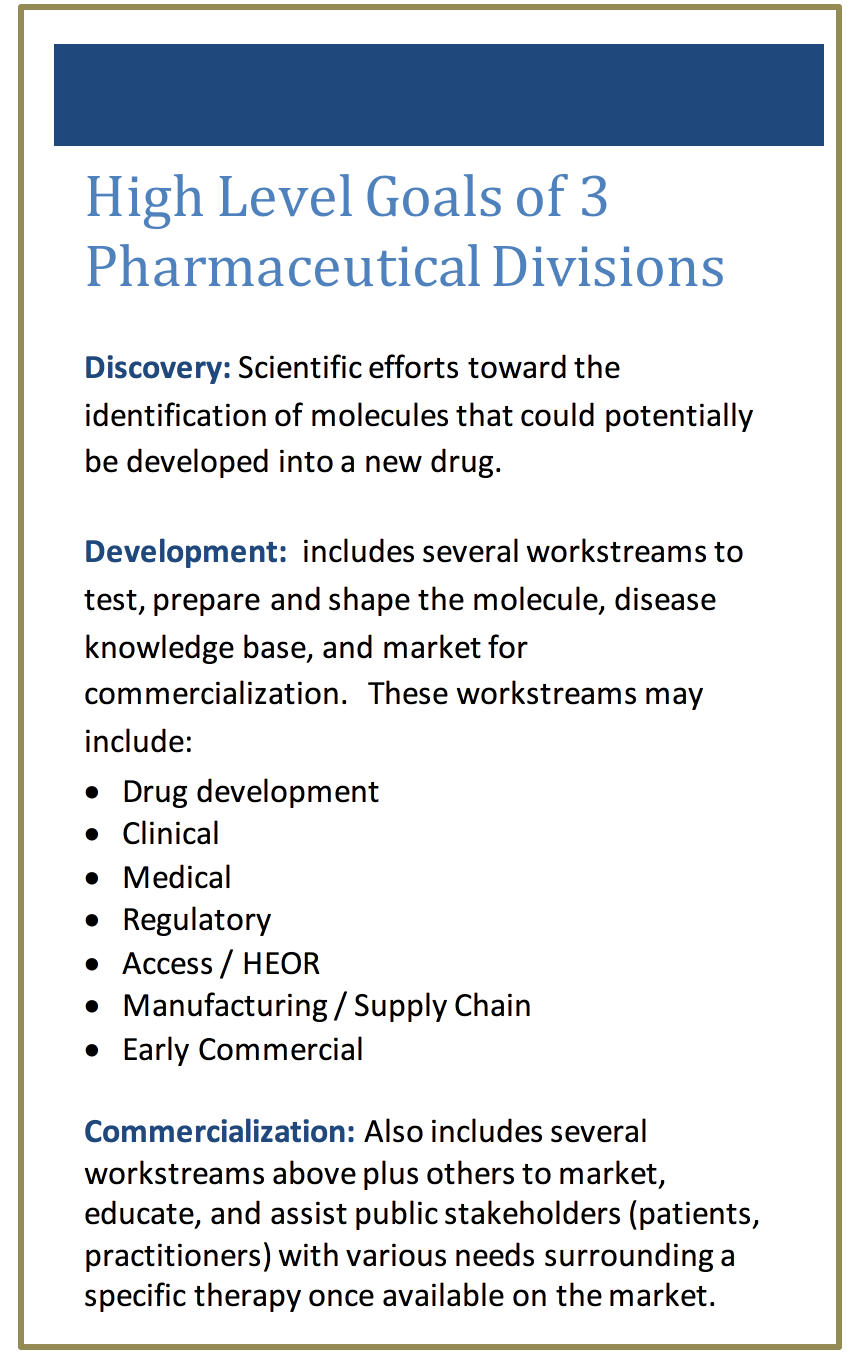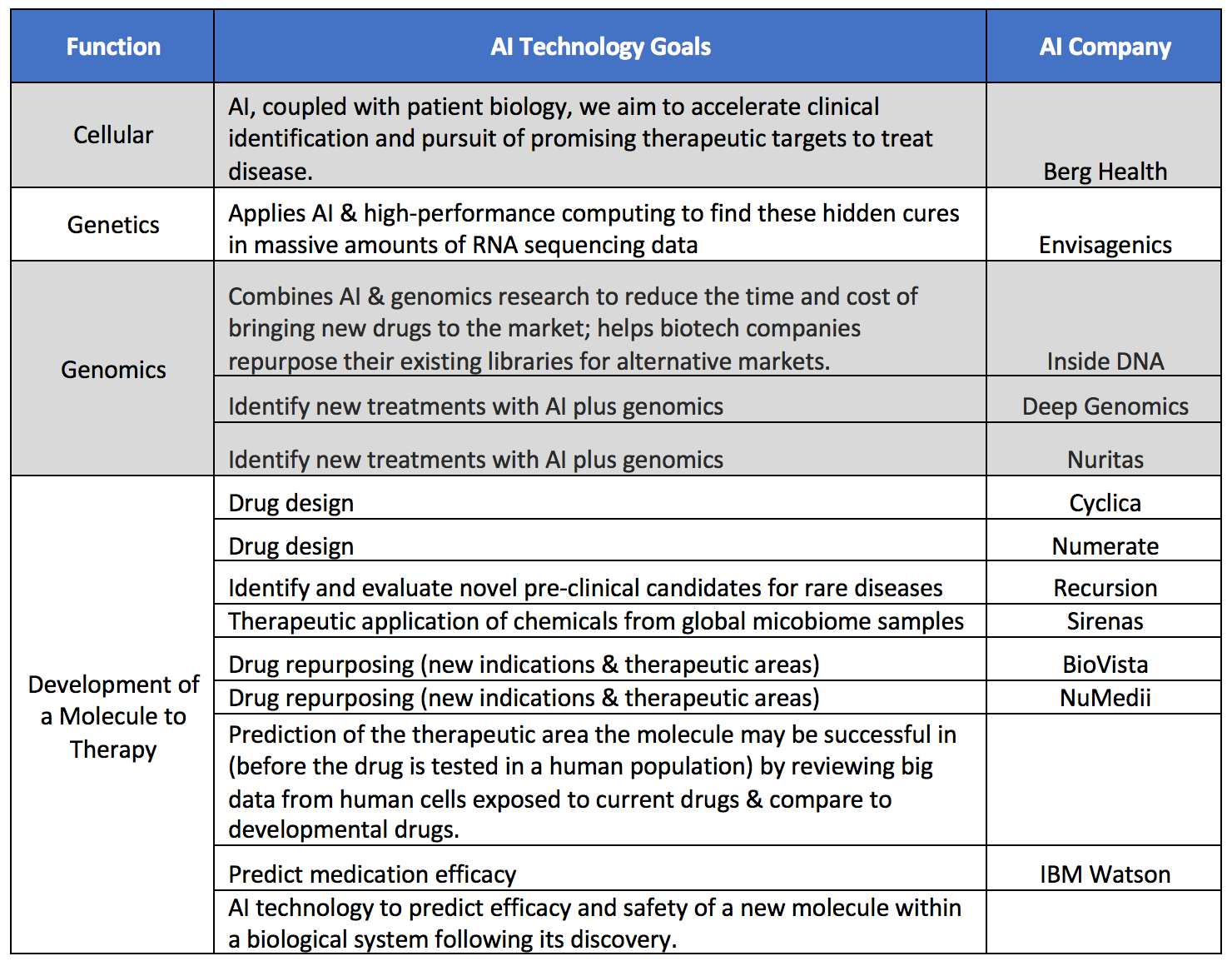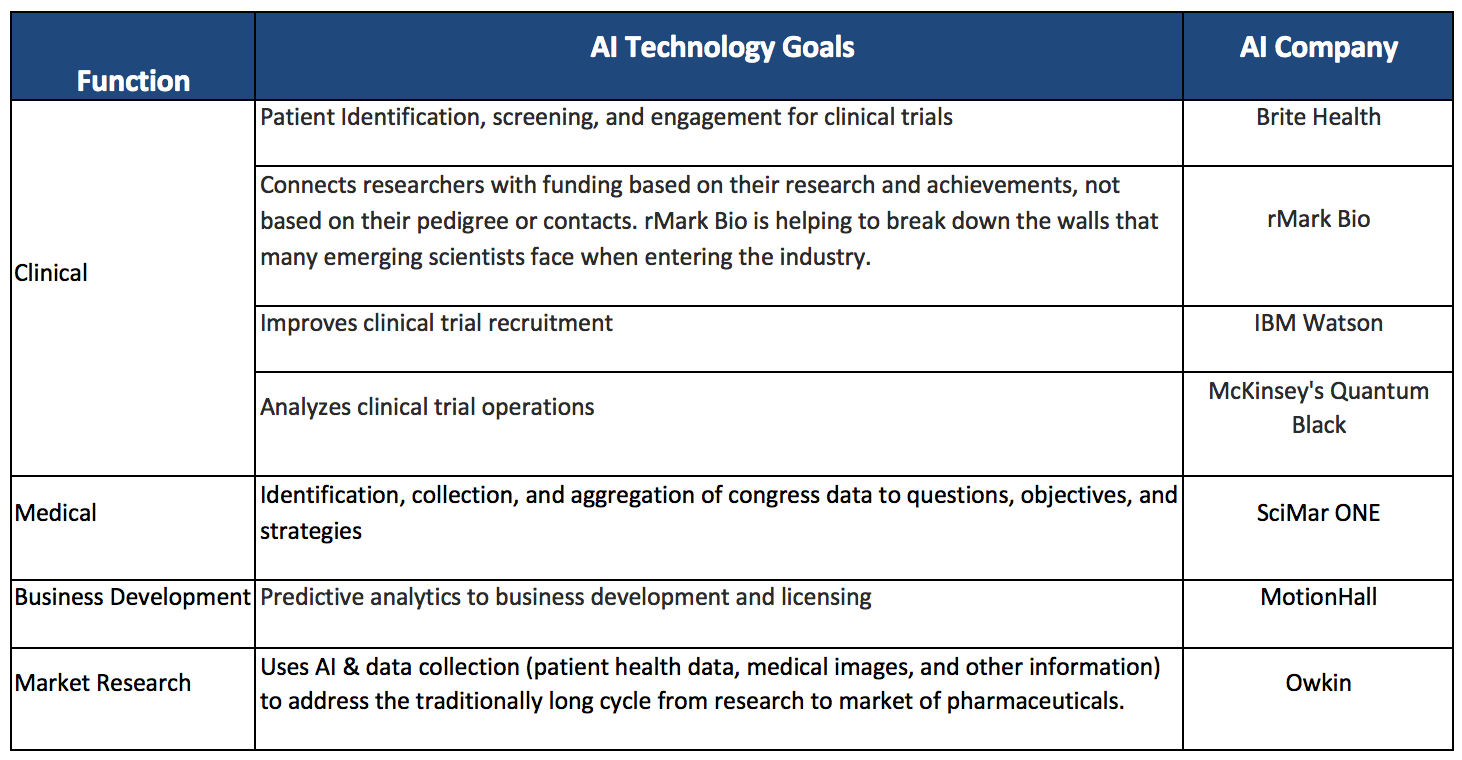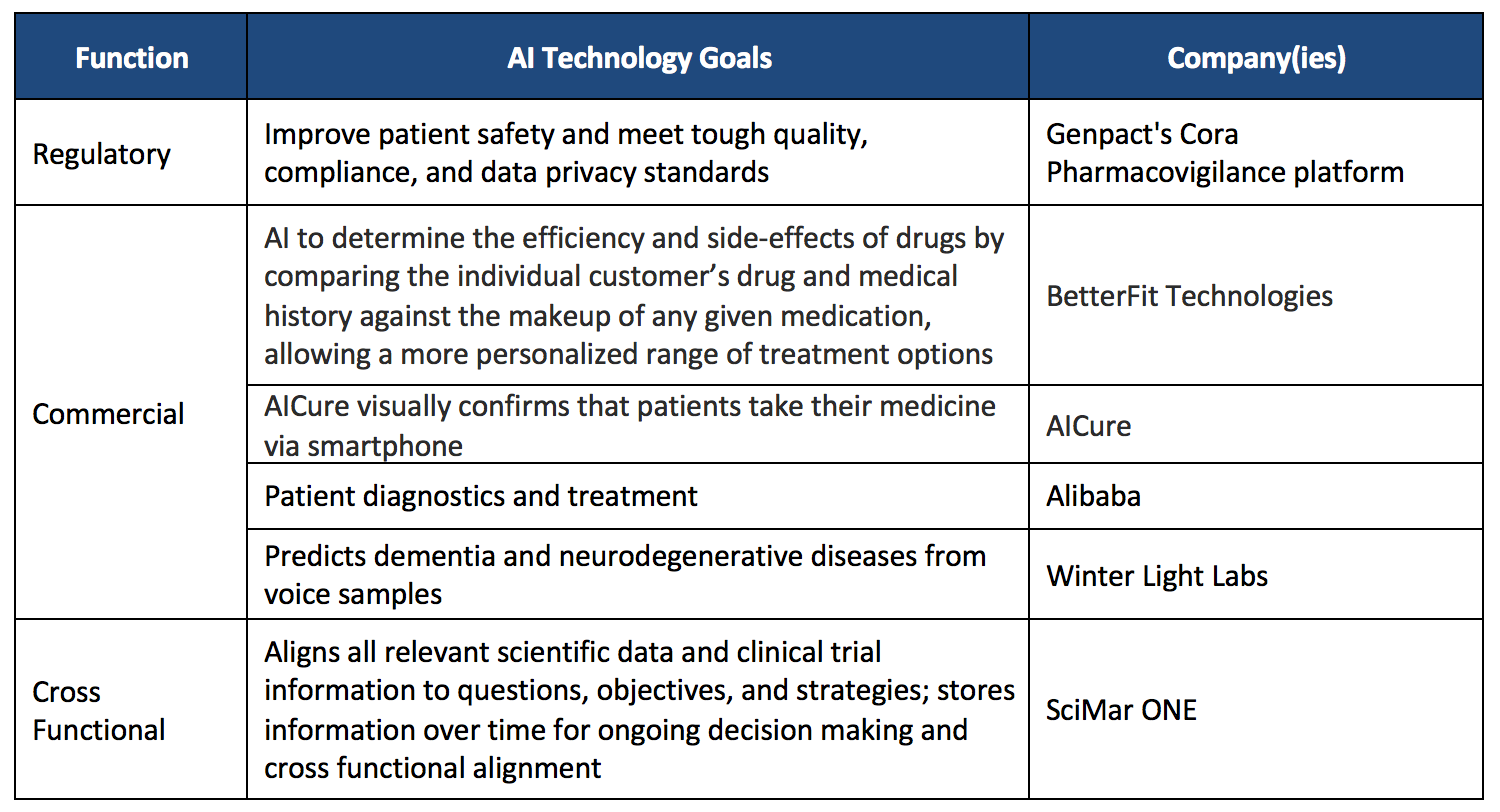AI in Pharmaceuticals
Drug discovery to development through commercialization.
The utility of artificial intelligence (AI) has and is being explored in a multitude of industries with the healthcare industry being a core focus of AI research. Healthcare is a complex industry and AI needs for each component will vary. Over-simplifying these needs by classifying them into one category called “healthcare” is impractical and unactionable for individual industry stakeholders. Most involved in healthcare would segregate pharmaceuticals needs from a healthcare practitioner, patient, regulatory body, or managed care organization’s needs. Yet mainstream information aggregates AI information into one healthcare-related venture. While a variety of healthcare-focused AI development projects and offerings are on the forefront, most articles, tweets, and posts focus in two areas: patient care (specifically diagnostics and treatment recommendations) and pharmaceuticals (with the majority focused specifically on drug discovery). A comprehensive overview of the current utility of AI in pharmaceuticals, a critical component of the healthcare industry, lacks in the literature. This significant information gap provides us the opportunity to investigate and understand the potential areas where AI projects could influence and perhaps enhance the role of the pharmaceutical industry to advance healthcare. This paper shares current insights into the utility of AI encompassing the pharmaceutical industry (drug discovery to development and through commercialization).
We hope to achieve three goals in this paper. First, to define AI in context of the pharmaceutical industry in order to provide a baseline understanding and stir the creative juices of the reader. Second, to describe the current utilization of AI in pharma plotted over three core divisions (drug discovery, development, and commercialization). Lastly, to highlight a variety of considerations for pharmaceutical companies making or contemplating an internal AI investment.
What exactly is artificial intelligence, and how can we use it?
In simplistic terms, AI has the capability to utilize massive amounts of data for a single or many tasks. Machines can store and access limitless volumes of information in their memory and apply it quickly to a predefined goal/task (or application). The simplified high-level challenge with AI is that it can’t fully decode why specific data is important to answer a question OR have the emotional intelligence to determine which result is most relevant. Currently, computers lack understanding. Therefore, it is easy to agree with the world’s leading AI exerts/developers regarding the utility and practicality of AI.
AI should be used for the tedious and monotonous tasks incorporated in our daily work. A majority of well-known leaders in AI believe it will best be utilized on tasks that are repetitive and lack efficiency, and we agree. When considering the pharmaceutical industry, AI tasks should be low risk, do no harm to patients, and reduce overall costs facilitating downstream drug costs reductions. Recognizing that tedious tasks in pharma are generally associated with large amounts of data, it becomes clear that AI and pharma could partner. A multitude of “big data” tasks in the drug discovery to development and through commercialization process already exist. The efficiencies derived from AI can be an invaluable tool for the pharmaceutical process.
On the other hand, humans tend to understand the question/goal and can easily associate the “why” behind potential answers relating to a question. Humans are generally well suited with the wisdom and emotional intelligence to “do no harm” when a multitude of outputs/options are offered. Our human challenge is that we lack the memory and/or ability to quickly access the volumes of data that may be stored in the brain to correlate a multitude of options. When you think about it, AI has the potential to be the yin to our human yang in a check and balance system.

The core differentiators between the capabilities of a human and of artificial intelligence could be incorporated into a new hybrid model within the pharmaceutical industry whereby AI assists humans to carry out daily tasks with efficiency and expertise. AI may have the “intelligence” for excellence with critical, yet repetitive, tedious tasks such as identification of a new therapy, while our human “wisdom” is left with qualifying true unmet medical needs, an appropriate balance of efficacy vs. adverse events, an acceptable range on quality of life and human mortality when taking that therapy. If the AI-Assisted model is adopted, humans who understand, accept, and utilize AI to carry out their daily book of work will become the experts in the future.
Current utility of AI in pharmaceuticals
Exploration of AI in pharma will be broken down into three divisions typically established in many organizations: discovery, development, and commercialization. The box below contains over-simplified, high level goals carried out within each division. When thinking about utilizing AI within the pharmaceutical process it is crucial to remember that AI is best suited for repetitive tasks where efficiency lacks. AI-assisted pharmaceutical tasks should be low risk, do no harm, and reduce costs. Most pharmaceutical companies suffer with gaining efficiencies in financial spend and time. We have personally witnessed reorganization after reorganization in companies who seek these efficiencies.
Generally speaking, the discovery period is associated with large spend and long timelines; in contrast, the development period suffers with a fairly small financial spend and shorter timelines; finally, commercialization generally offers accessibility to financial spend with the opportunity to optimize and recapture discovery and development spend realizing that patent protected commercialization is heavily dependent upon truncating the time between an IND submission and the regulatory approval.
AI Efforts in Discovery
Most current AI efforts in pharmaceuticals are focused on a specific division: drug discovery

Our findings indicate that drug discovery is where most pharmaceutical companies are exploring incorporation of AI today. One reason why may be because this segment in the pharmaceutical process does not impact patients and is, therefore, low risk from that perspective. Another reason may be that supercomputing has strong roots in drug discovery. Machine learning technology, which includes a variety of parameters such as genomics, molecular, and cellular structure databases have been established for some time now. Numerous companies have built upon pre-existing models and/or built their own machine learning models to progress our knowledge base. The volume of data incorporated in these machine learning systems is incomprehensible to the human mind. AI has the potential to provide the best path forward required for the efficient analysis of complex and large data sets. Comparatively speaking, human identification of new molecules has been slow and less cost effective. Identification of a new molecule requires big data sets and lengthy timeframes when completed by humans. However, AI is changing this process significantly. AI is more efficient in predicting potential prospects in drug discovery, yet the check and balance system is required as a human still needs to observe and validate the necessity and appropriate utility of a molecular substance for human consumption. Drug discovery completed with AI is expected to surpass human capability and assist with the identification of more therapies to treat more diseases in a shorter timeframe. The public hope is that overall drug costs are reduced due to the efficiency savings. All corporate posts identified for this research are focused on incorporation of AI in discovery and/or translational medicine. When AI in healthcare is mentioned, pharmaceutical drug discovery is always the first or second topic of discussion.
Drug Development: Once a molecule is identified as a potential therapeutic option, the molecule must be converted into a drug/therapy viable for human consumption. Some pharma companies may place this function early in the drug development process vs. an extension of the drug discovery function. Regardless of how one may categorize this key task is secondary to the exciting AI projects that are under development. One company uses AI technology to predict efficacy and safety of a new molecule within a biological system following its discovery. Another company is focused on the prediction of the therapeutic area the molecule may be successful in (before the drug is tested in a human population) by reviewing big data from human cells exposed to current drugs and compare to developmental drugs. In addition, this process has been noted to assist in identification of secondary (lifecycle) opportunities for molecules. Both organizations appear to be reducing the risk while optimizing the success of drug development by further testing molecules in-vitro.

Additional functions within drug discovery exist, but we did not identify any AI efforts specifically supporting these other functions. We did identify additional companies concentrated on AI in drug discovery, although the description of their capabilities and how they support a specific function is more cryptic.
We would be remiss if we neglected to mention that the Massachusetts Institute of Technology (MIT) has compiled the “Machine Learning for Pharmaceutical Discovery and Synthesis Consortium.” This group is a collaboration between the pharmaceutical and biotechnology industries and the departments of Chemical Engineering, Chemistry, and Computer Science at MIT. The goal of the collaborative efforts is to facilitate the design of useful software for the automation of small molecule discovery and synthesis. Pharma companies currently involved in the consortium include:
- Amgen
- BASF
- Bayer
- Lilly
- Novartis
- Pfizer
- Sunovion
AI Efforts in Development
A significant gap exists for AI within the development division.
Due to its very nature, the drug development process requires much more of the human condition-wisdom, experience, intuition, and the ability to pivot quickly. Pharmaceutical workstreams typically activated during the drug development phase are routinely sub-specialized. Tasks during this time require empathetic insights to evaluate varying treatment and disease-related data sets relevant to physicians, patients, or payors. The ability to pivot quickly during this development phase is crucial while everyone is learning. Intuition and empathy are elements within human intelligence “yet” to crossover into the realms of AI and the “techno-sphere” in general. AI currently lacks the ability to interpret, assess, and pivot due to these deficiencies. As such, humans are likely best suited to most drug development tasks today, but it isn’t stopping many organizations and vendors from exploring potential AI opportunities with micro-tasks that assist with this type of decision making to expediate the process.
While very few AI efforts have been found in this research for this paper, it must be acknowledged that a multitude of companies and agencies working in this segment may have ongoing efforts which are non-public facing and proprietary at this time. Some interesting AI projects uncovered in our research are described below.
Clinical Development: The use of AI during the development stage is becoming a popular trend with several pharmaceutical companies. Using AI to both identify patients for clinical trials is becoming a standard out of necessity for a myriad of reasons. The most eminent reason being the “first to market” in the great race of clinical trial enrollment. Using AI to get to the “right” patient first to enroll in your clinical trial over your competitors is critical. One company, named in the top 10 of AI companies in healthcare in 2018, offers patient screening and engagement (to characterize the appropriateness of a patient for higher and longer trial attrition), in addition to patient identification. Some pharma companies are beginning to develop their own clinical trial AI (e.g., Novartis’ “NERVE”) but a great majority still rely upon their CRO vendor to develop systems that lead to faster enrollment with more appropriate patients. The success of each proprietary AI system varies from CRO to CRO likely due to a variety of differences in the type of data they are using and the ability to standardize that data for optimal outcomes.
Medical Development: Using AI to stay abreast of past and current clinical data with insight into a potential future just makes sense when publications, data releases, presentations, etc. are relentless. Our finding, however, is that most organizations are simply trying to organize this information into Sharepoint and non-AI digital libraries. Unfortunately, these antiquated tactics do not address the challenge medical affairs encounters: quickly and efficiently providing medical-based answers to rather in-depth clinical and business questions/objectives and highlighting data gaps to cross-functional teams.

Additional functions within development exists. We did not identify any AI efforts supporting these specific functions. They include:
- Commercial
- Competitive Intelligence
- Regulatory
- Access/HEOR
- Manufacturing/Supply Chain
AI Efforts in Commercialization:
More AI development is targeted for commercialization vs development tasks, but still trifle compared to the efforts placed on drug discovery.
This came as a surprise to us. Why? Large amounts of the data needed during commercialization are unstructured, which complicates the inclusion for evaluation from an AI perspective. So why are many AI development efforts focused here? The answer may be financial in nature. It is common knowledge that as the likelihood of a drug advancing from development to commercialization increases, the pharmaceutical spend magnifies with the most open purse available during commercialization. Another reason may be the instantaneous satisfaction gained when it is clear this tool helps patients. Healthcare at the core is about the advancement of better patient care, so efforts that directly impact patients just make sense. Some AI development efforts within commercialization include the personalization of medicine (i.e., increasing the opportunity to deliver a new therapy to all the targeted patients, or determining a new therapy’s efficacy and side-effects profile for one specific patient or patient group). The adoption of AI applications in the pharmaceutical process will hopefully lead to an unbiased and personalized range of treatment options for the patient. Traditionally, treatment options have been developed in the shadow of static algorithms and protocols, sole prescriber experience, external industry influences and other bias. We expect there are a multitude of AI development efforts, but it is obvious that some may truly affect, shape, and define commercialization success for the benefit of the patient. Some of these include:
- Precision Medicine / Predictive Medicine: treatment protocols are predicted for a given patient rather than a group of patients
- Medical diagnostics and radiology applications are “read” using some form of machine learning
- Customer service “bots”
- Adverse event detection and reporting directly to the FDA
- Cross–company quality assurance

Conclusion
The AI-Assisted Approach will increase successful drug discovery to drug development through commercialization. AI may provide the initial intelligence/molecule identification essential to the discovery process, but the incubation necessary to migrate into the development phase will likely continue to be output of a techno-human hybrid effort. AI-assisted drug discovery applications will deliver efficiencies in the analysis of large data sets leading to identification of new therapies. Subsequently, offering a new therapy to patients is an over simplification of a highly complex initiative. Once identified, the new molecule is subject to the evaluation and scrutiny from a human component, leveraging acquired wisdom and experience as the basis for the decision making as it progresses towards commercialization. Needing an answer or direction, a wide range of decisions effect the progress of the new therapy. This range of decision (usually requiring swift answers) negates an “all- AI” option if we agree on utility with tedious and monotonous tasks and the need to program a new task with each question. Some examples of these evaluations include the qualification of the new therapy:
- Does it address a true unmet medical need?
- Will the therapy deliver an appropriate balance of efficacy vs. adverse events?
- Can it meet an acceptable range on quality of life and human mortality criteria (which varies patient to patient)?
In conclusion, we anticipate the future success of a pharmaceutical company will belong to the executive leaders who understand and properly incorporate AI in their product work streams, while respecting the experience and expertise of their people. This opinion is Darwinian in nature. To survive we must evolve. The capabilities of machine learning and AI have evolved significantly since 1996 when Deep Blue (IBM’s chess playing computer) beat a world champion chess player. The concepts of a phone that takes direction from us and cars that self-drive are no longer foreign, but present. People that accept and adopt AI as a possibility in their daily work streams will not only be the evolutionary survivors of their individual jobs, but also the successes of their companies.
Methodology
Research for this paper began with the development of key search terms including “artificial intelligence” and variations of the words “artificial intelligence and pharmaceuticals” (ex: AI, pharma etc.). The search terms were general by design in order to capture a large volume of data. Results of the core search terms were evaluated from multiple internet searches, TED talks, YouTube video’s both on and beside their artificial intelligence channels. From there we were able to identify leaders in AI and then followed their workstream to better understand current and future capabilities of AI. Next, we explored the Discovery Channel which offered a documentary on AI (sponsored by IBM-Watson). LinkedIn offered optimistic results with the identification of AI and technological uses within individual pharmaceutical company’s corporate posts, yet these were vague at best. LinkedIn also offered a plethora of “leads” to content relevant to this body of work. A PubMed search for clinical papers and use of AI in pharma offered additional relevant information. Finally, we attended live conferences whose content included AI in pharmaceuticals. While we feel the work to identify reliable sources for this paper was exhaustive, it is extremely likely there is more AI research and development from pharmaceutical companies, supporting vendors and stand-alone companies not acknowledged in this paper. However, knowledge of these efforts is limited/or unknown as this research is likely in development rendering it proprietary and therefore non-discoverable currently. It is important to note that limited results from an exhaustive methodology in and of itself represent a large information void offering further justification for the need to assimilate and describe the current and future use of AI in pharmaceuticals.
References
- https://blog.benchsci.com/pharma-companies-using-artificial-intelligence-in-drug-discovery updated in Jan. 2019 by Simon Smith- list of AI companies working by Pharma company.
- How Data Analytics And Artificial Intelligence Are Changing The Pharmaceutical Industry. https://www.forbes.com/sites/forbestechcouncil/2018/05/10/how-data-analytics-and-artificial-intelligence-are-changing-the-pharmaceutical-industry/#3727cbd63644
- Artificial Intelligence Already Revolutionizing Pharma. http://www.pharmexec.com/artificial-intelligence-already-revolutionizing-pharma
Donna Conroy, MS is founder of SciMar ONE. Mike Conroy is part owner of SciMar ONE.
Is Artificial Intelligence a ‘Product’? Products Liability Implications for AI-Based Products
April 10th 2025As the physical products we use evolve to become increasingly complex, traditional products liability frameworks may not always fit to provide remedies for harm that can result from using novel product types.